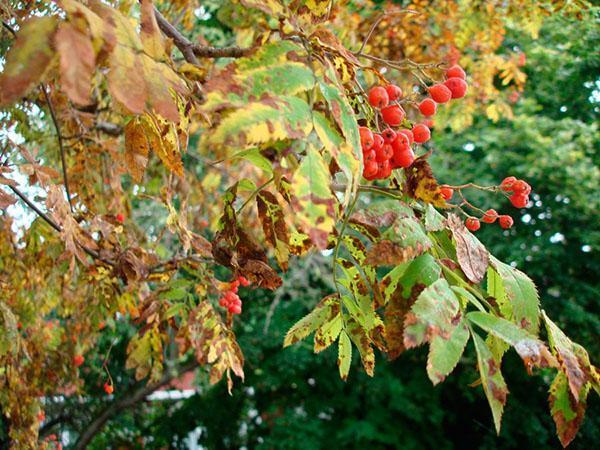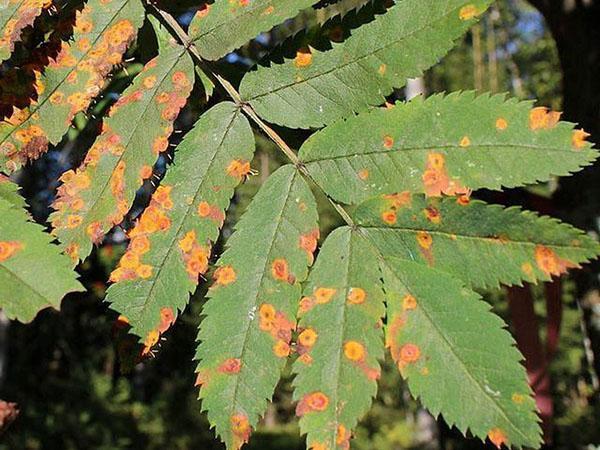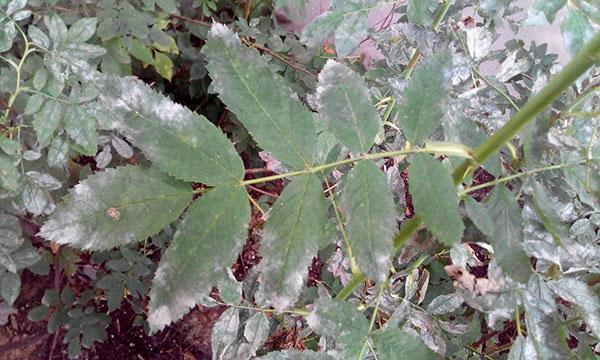We study the diseases of mountain ash and begin the fight
 There are various diseases of rowan ordinary. But if you know how to deal with them, you can grow a beautiful and healthy tree that will delight you with abundant flowering and colorful berries.
There are various diseases of rowan ordinary. But if you know how to deal with them, you can grow a beautiful and healthy tree that will delight you with abundant flowering and colorful berries.
Deciduous plate diseases

The main sources of the disease are fallen leaves, on which pathogens have settled.
The main diseases of deciduous plates:
- Powdery mildew... The cause of this disease is a powdery mildew. A similar problem appears in the second part of July. The leaves are covered with white cobwebs. If nothing is done, then after a short time spherical fruits are formed on the surface of the plates. Initially, such points have a yellow tint. They can be located both singly and in groups. Ripe formations change their color over time and turn dark brown.

- Rust. Such a disease appears as a result of the development of a diverse rusty fungus. The spring stage of such a mushroom appears in the first half of summer. You can determine such a problem by the presence of pinkish spots on the leaves. They are often located on the top plate and are quite large. The diameter of each formation is 2 to 5 mm. On the lower part of the leaves, sometimes cone-shaped growths of brown color may appear. Their length ranges from 1 to 2 mm. Basidia with basidiospores winter on the trunk of a mountain ash, and in the spring they infect young leaves. If you do not carry out any treatment, then in the near future the plates will change color and begin to deform.

- Brown spotting. The cause of this problem is the mushroom Phyllosticta sorbi. You can distinguish such a disease by the presence of brown spots that cover the leaves in the second half of summer. They come in different sizes and shapes. In the middle of each speck there are black dots, which are pycnidia. They appear on the top of the plates and develop quite quickly.

In addition to these diseases, there are other problems that require a closer acquaintance.
Gray spot
 Phyllosticta aucupariae is the cause of this problem. It strikes both sides of the plate. On the surface of the leaves, gray spots with a dark border are formed. They can be either correct or not correct. They often combine and form huge spots that can cover most of the plates. On the affected areas, which are located on the upper part of the leaves, there are pycnidia in the form of black small dots.
Phyllosticta aucupariae is the cause of this problem. It strikes both sides of the plate. On the surface of the leaves, gray spots with a dark border are formed. They can be either correct or not correct. They often combine and form huge spots that can cover most of the plates. On the affected areas, which are located on the upper part of the leaves, there are pycnidia in the form of black small dots.
Gray rot can affect different types of mountain ash.
Scab
It is one of the most common diseases caused by the fungus Fusicladium orgiculatum. It appears scab in the form of spots that are located on both sides of the plates. They have a brown hue and radiant edges. Often, the edging is irregular, but there are spots with perfectly straight edges.
If you do not fight such a disease, then the tree will quickly lose its attractiveness. The second stage of development of the fungus Fusicladium orgiculatum is the presence of olive bloom on brown spots.
Scab develops most actively during the period of heavy rains. She also feels good in heavy fogs, which increase the humidity of the air.
Ring mosaic
Such a disease manifests itself in the spring. Greenish rings are formed on the leaves. With a large number of them, a mosaic pattern appears. If the deciduous plates are severely affected, then they begin to deform and fall off.
Diseases of the trunk and shoots
 Various diseases affect not only the leaves of mountain ash.
Various diseases affect not only the leaves of mountain ash.
Necrotic diseases
Pathogens that infect the plant penetrate into the tissues through damaged areas of the bark. The main sources of this disease are infected trees and bushes. Fallen and unharvested leaves, in which such a pathogen lives, can also cause necrotic diseases.
If young shoots have such a problem, they often disappear. Especially if the temperature is high on the street for a long time and there is no precipitation in the form of rains. Also, necrotic diseases develop in the case of polluted air or as a result of an incorrectly selected site.
Noncrowned necrosis
 This disease is often called tubercular necrosis. It appears as a result of the fungus Tubercularia vulgaris. It is almost impossible to immediately identify this disease. This is due to the fact that the shade and structure of the bark does not change in the early stages.
This disease is often called tubercular necrosis. It appears as a result of the fungus Tubercularia vulgaris. It is almost impossible to immediately identify this disease. This is due to the fact that the shade and structure of the bark does not change in the early stages.
Non-crestal necrosis appears in the form of pink pads with small cracks in the bark. They are often smooth and round. In diameter, such formations grow from 0.5 to 2 mm. Such growths are formed during the year, but infection occurs only during the growing season.
Cytosporous necrosis
 This problem manifests itself in the form of oval formations that have a yellow tint. They are formed only on the bark of a tree. Such a necrosis grows very quickly. The result is a huge spot that can cover most of the shoot.
This problem manifests itself in the form of oval formations that have a yellow tint. They are formed only on the bark of a tree. Such a necrosis grows very quickly. The result is a huge spot that can cover most of the shoot.
In the spring or summer months, mucus is released from these pads. It has a dense structure, so it does not dry out, but solidifies in the form of drops.
Biscognioxium necrosis
 This type of necrosis affects different types of mountain ash. It affects the bark of both young and adult trees. This problem manifests itself in the form of cracks in the bark. If you do nothing, then over time it will begin to flake off and fall off.
This type of necrosis affects different types of mountain ash. It affects the bark of both young and adult trees. This problem manifests itself in the form of cracks in the bark. If you do nothing, then over time it will begin to flake off and fall off.
All of the above diseases of mountain ash, often appear as a result of weakened immunity of the tree. The reason for this is improper plant care, sudden temperature fluctuations or prolonged drought.
Tell me how to treat the "rust" of the sheets? leaves dry in the middle of summer rust? (as in the first photo)
The fungus, the causative agent of the disease, winters very well in fallen leaves. Therefore, in the spring, be sure to remove all plant debris under the mountain ash, so that next year the disease does not have a chance to develop further. In addition, in early spring, before the buds bloom, treat a tree or bush with a Bordeaux mixture of 1% concentration. Also, HOM, Abiga-Peak preparations are suitable for spraying.